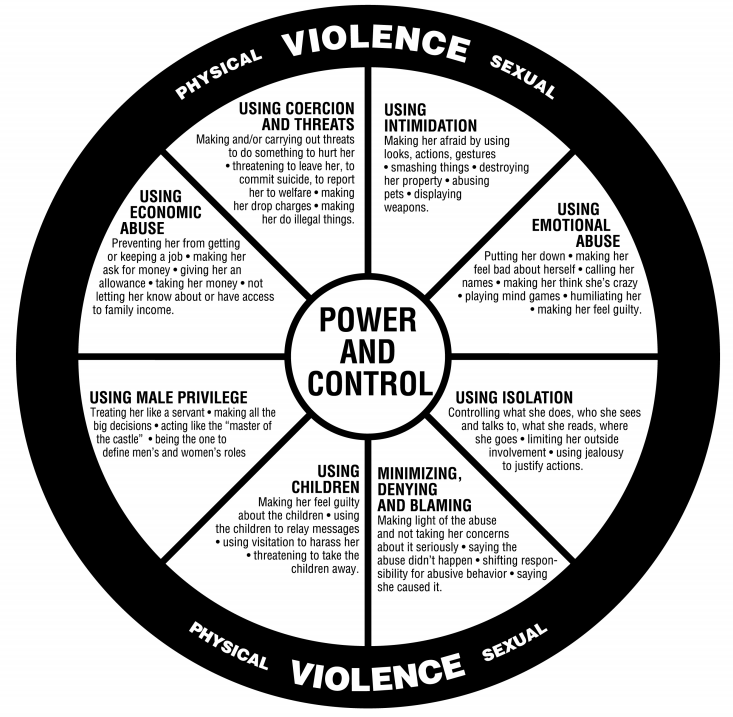What is domestic violence?
Domestic Violence (DV), also called Intimate Partner Violence (IPV) is a pattern of abusive and coercive behaviors that abusers use to control their intimate partners. It is intentional behavior with the purpose of exerting control and power over another person. DV or IPV is fluid and is a pattern of behaviors, not a single event or isolated incident.
Anyone can experience domestic violence. It affects all genders, races, religions, sexual orientations, and socioeconomic backgrounds. The Power and Control Wheel shows tactics that an abusive partner may use to keep a victim in the relationship. (Please note that though this wheel uses she/her pronouns for the victim and he/him pronouns for the abuser, abuse can happen to people of any gender.)

Copyright by the Domestic Abuse Intervention Project
Types of Abuse
Physical Abuse
Probably the easiest kind of abuse to recognize and understand. Aggressive physical contact should always be considered abusive and taken seriously. Keep in mind, physical abuse does not always cause marks or permanent damage.
- Punching, hitting, slapping, scratching, burning
- Biting and spitting
- Pushing, shoving
- Holding, restraining, grabbing
- Strangling, choking
- Inflicting bruises, welts, lacerations
- Dragging, pulling by hair
- Throwing objects
- Destroying possessions
- Attacking or threatening to attack with a weapon
- Any threats or attempts to kill you
- Marking, branding
Emotional Abuse
Any behavior, verbal or non-verbal that your partner uses to control you and diminish your emotional well-being.
- Threatening, intimidation
- Name-calling, mocking
- Intimidation
- Manipulation
- Controlling where you can and cannot go
- Placing little or no value on the things you say
- Twisting your words/using your words against you
- Belittling you/putting you down
- Isolating you from friends or family
- Blame
- Humiliation
- Extreme jealousy/possessiveness
- Threatening acts of violence
- Constant criticizing
- Insulting/belittling
- Gas-lighting
- Ignoring or dismissing you
- Denying, minimizing and blaming
- Invading privacy
Sexual Abuse
Any sexual encounter that has occurred without your consent.
- Coercing victim to have sex
- Unwanted touching
- Rape: actual or attempted unwanted vaginal, oral, or anal penetration by an object or body part
- Making victim watch pornographic videos
- Sexually transmitted diseases
- Demanding sexual photos/taking film or videos without your consent
- Using date rape drugs
- Sabotaging birth control/withholding contraception
- Denying use of protection
- Trafficking (forcing you to have multiple sex partners)
Financial Abuse
Measures taken to ensure that you are entirely dependent on them in order to gain the utmost control or to prevent you from leaving.
- Withholding money/limiting funds
- No access to bank accounts/ATM and credit cards
- Ruining victim’s credit
- Accruing debt in victim’s name
- Taking victim’s paycheck
- Gambling
- Forbidding victim to work or attend school
- Sabotaging or jeopardizing employment/education
Technology Abuse
This form of abuse includes the use of technology to control and stalk a partner.
- Tracking location
- Demanding check-ins
- Excessive texts
- Spyware
- Spoofing/catfishing
- Monitoring communications
- Positing on social media
Legal Abuse
Unfair or improper legal action initiated with selfish or malicious intentions.
- Constant threats to gain custody of children
- Excessive filing of motions at court
- Using parental rights to contact victim
- Calling DCF
Stalking/Harassment
A pattern of repeated behavior that includes unwanted attention, contact, harassment, or other conduct towards a specific person.
- Making unwanted visits or sending you unwanted messages
- Following you
- Checking up on you constantly
- Embarrassing you in public
- Refusing to leave when asked


